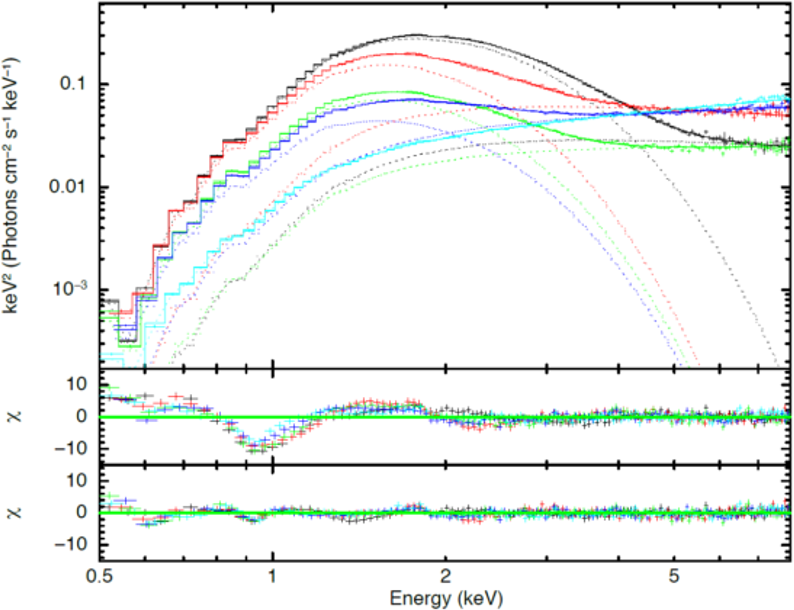NICER / ISS Science Nugget
for April 20, 2023
Answers blowing in the wind
Binary star systems are plentiful in our Galaxy, and the many types of interactions between orbiting stars offer a rich laboratory for studying astrophysical processes and fundamental physics. Accretion, or the flow of matter from one star to another, is among the most common engines underlying the emission of X-rays and other high-energy radiation; it also drives - through mechanisms that remain poorly understood - ejection of matter from the binary system, even from the vicinity of strongly gravitating objects such as black holes and neutron stars. These outflows, in the form of collimated jets and diffuse "winds," have a substantial impact on the overall energy budget of such systems, and on their long-term evolution.
The binary system known as MAXI J1810-222, thought to harbor a black hole drawing matter from a Sun-like companion, was observed with NICER between February 2019 and September 2020, during a relatively bright outburst phase. A paper by M. Del Santo (Italy's National Institute for Astrophysics) and collaborators, accepted this week for publication in the peer-reviewed UK journal Monthly Notices of the Royal Astronomical Society, describes a study of this NICER dataset in which a surprising finding emerged. MAXI J1810 is producing a diffuse but ultrafast outflow, unlike any seen from similar binary systems. Evidence for the outflow appears in the form of an absorption dip in the X-ray spectrum: some of the X-ray emission from the hot disk of accreting gas is passing through, and being absorbed by, an ionized gas before reaching us. The details of that absorption - its characteristic energy (near 1 keV in this case), its breadth in energy, and its depth - carry information about the velocity, temperature, ionization state, and other properties of the absorbing gas, and they change with time as the system's accretion-powered outburst progresses.
Relativistic outflows (those moving at a significant fraction of the speed of light) are known from so-called ultraluminous systems, in which the photon flux from the innermost accretion flow is so intense that it pushes matter out in front of it and accelerates it to high speeds. But MAXI J1810 is not ultraluminous - it falls below the so-called Eddington luminosity at which pressure from photon radiation inhibits matter flows - so another mechanism must be responsible for powering its high-speed outflow. The team investigating the NICER data propose that the most likely scenario in the case of MAXI J1820 is that magnetic fields generated by the swirling gas near the black hole are ultimately responsible for accelerating the ionized wind to speeds up to 15% of the speed of light. This represents the first evidence for such a process in a stellar-mass black hole system, with implications for studies of winds and the long-term fate of such binaries.

Figure:
NICER spectroscopic data for the presumed black-hole binary system MAXI J1810-222. X-ray photon detections are binned (points with error bars) according to their measured energies, while stepped traces in the top panel represent best-fit physical models of emission from the accretion process in the system. Colors indicate different intensity and "hardness" states of the binary, reflecting whether the emission is dominated by low- or high-energy X-rays (e.g., red and black vs. light and dark blue, respectively) at different brightness levels. The middle panel shows the difference between data and model, scaled by error-bar sizes, when the physical model does not include a wind component that absorbs X-rays near 1 keV energies, revealing a pronounced dip in the spectrum; the location, width, and depth of the dip are found to differ slightly across the various hardness-intensity spectra. The bottom panel shows the same data-minus-model spectrum residuals when an evolving wind component is included in the physical model. (Figure credit: Del Santo et al. 2023)
<< Previous
Main Index
Next >>